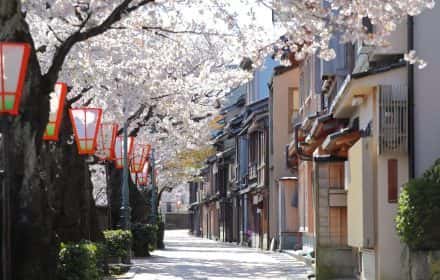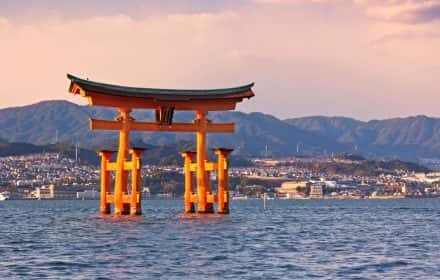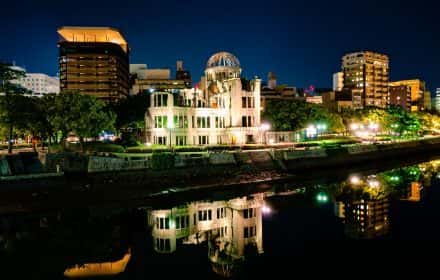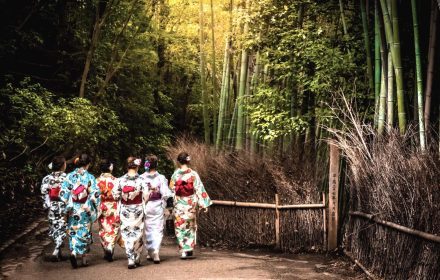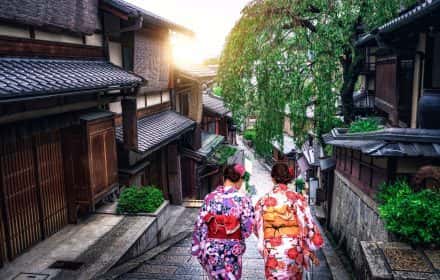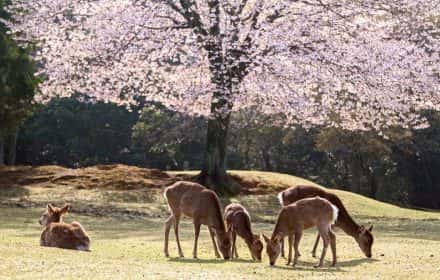This site uses affiliate links, meaning that if you make a purchase through our links, we may earn an affiliate commission.
Kenrokuen Garden is ranked as one of the top three most beautiful gardens in Japan. It is a must-see for any visitor to Kanazawa.
Each season transforms Kenrokuen Garden in its own way. No matter when you are visiting, you will be amazed by the beauty of this place.
Here is what makes Kenrouen a top-rated garden in Japan. Follow this guide to Kenrokuen Garden and find out all about it!
- 1. Kenrokuen - A Garden of Idealized Nature
- 2. Kenrokuen - A Garden of Six Qualities
- 3. Map of Kenrokuen Garden
- 4. Spring at Kenrokuen Garden
- 5. Kenrokuen Garden in the Summer
- 6. Kenrokuen Garden in the Fall
- 7. Winter at Kenrokuen Garden
- 8. Hours and Admission to Kenrokuen Garden
- 9. Hours and Admission to Kenrokuen Garden
Kenrokuen - A Garden of Idealized Nature
Kenrokuen Garden gives an impression of naturalness. Yet, there is nothing natural about it. It is a result of two centuries of dexterous remodeling of nature by the master gardeners of the feudal era.
The result is an expression of idealized nature where various elements of vegetation and topography are incorporated to enchant and surprise the senses.
Kenrokuen Garden was originally built as a private garden of the Maeda clan who ruled the Kaga domain for 14 generations.
Over the years, the garden was transformed to reflect the tastes of successive generations and was gradually enlarged.
Each ruling lord embellished upon the work of his predecessor, adding streams, bridges, waterfalls, and more.
Currently, Kenrokuen Garden covers about 10 hectares.
After the clan system collapsed at the beginning of the Meiji period (1868-1912), Kenrokuen became a public garden.
Kenrokuen - A Garden of Six Qualities
The name “Kenrokuen”, means “Garden of Six Qualities”.
“Garden of Six Qualities” references back to 11th-century Chinese literature, which dictated the six features of an ideal landscape: spaciousness, seclusion, human artifice, antiquity, waterways, and panoramic views.
It stated that a perfect garden was difficult to achieve since these six features were required to be grouped in mutually exclusive pairs like spaciousness and seclusion, human artifice and antiquity, waterways, and panoramic views. Yet, I think that the master gardeners of the feudal era incorporated all six qualities.
Kenrokuen has a sense of immensity and intimacy at the same time. The beautiful open spaces next to secluded walkways blend in beautifully.
Just like antiquity and human artifice intermingle with each other – weathered rocks, carefully tended moss, lanterns, tree roots, stones, and artfully trained tree branches.
And, water is everywhere: ponds, streams, fountains, waterfalls, and if you look into the distance in any direction, you have panoramas of mountains and hills.
Map of Kenrokuen Garden
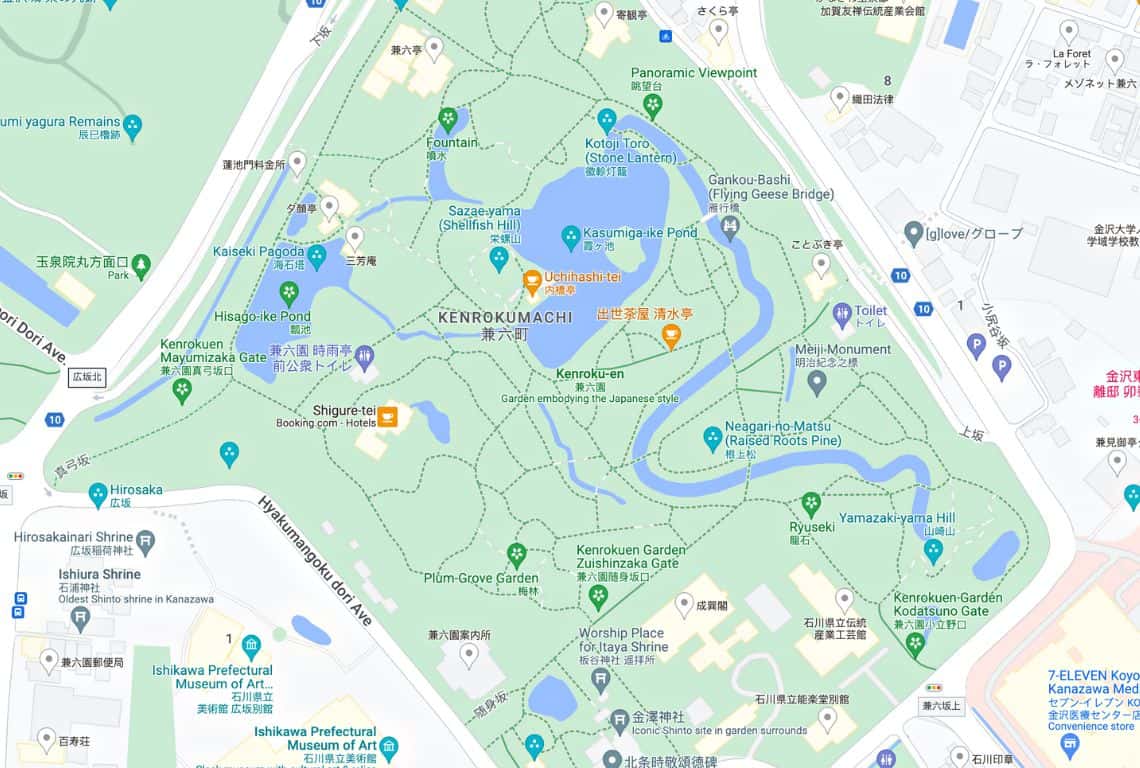
Map of Kenrokuen Garden
Spring at Kenrokuen Garden
Spring can be capricious in the Kanazawa area. The weather can change on the whim and the precious cherry buds sometimes struggle to survive under the late snowfall.
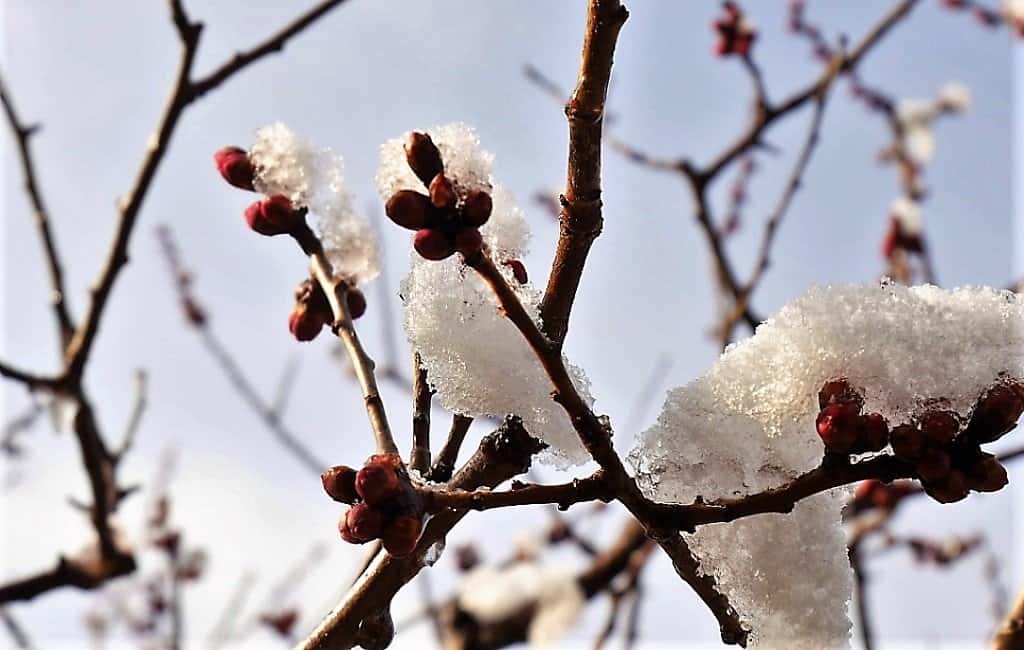
Spring at Kenrokuen Garden / Guide to Kenrokuen Garden
However, when the cherry blossoms finally fully open up, they are a sight to behold!
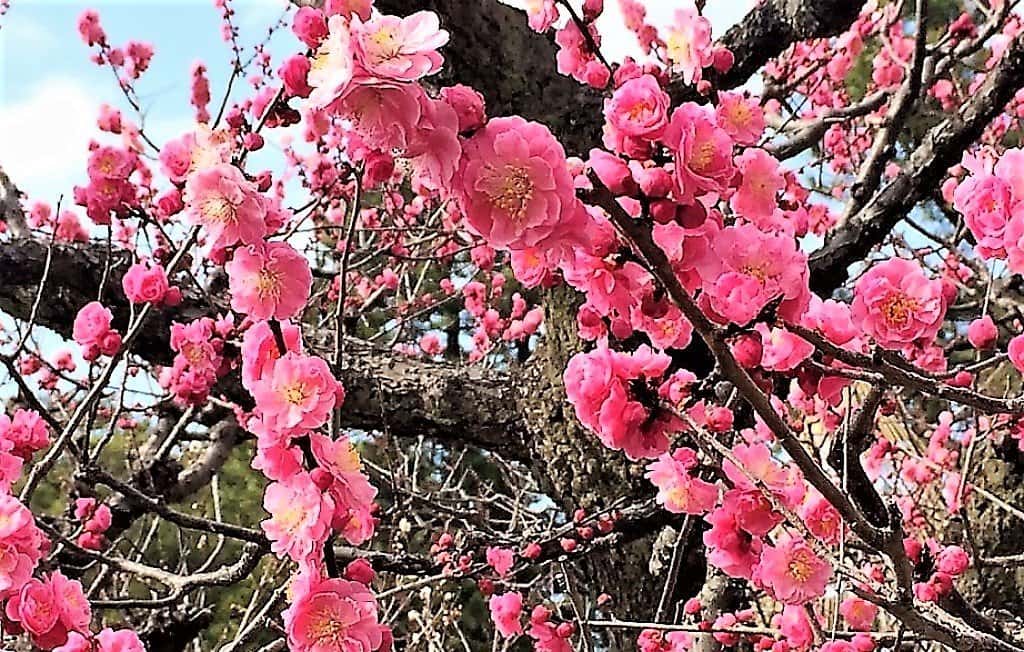
Spring at Kenrokuen Garden / Guide to Kenrokuen Garden
Kenrokuen boasts some 420 cherry trees, or sakura, ranging from the classic Somei Yoshino to other, lesser-known, but equally beautiful species such as Higan, Shiogama, Fugenzo, and Ukon.
The 40 different species represented on the grounds include some extremely rare varieties all but exclusive to Kenrokuen, including the Kenrokuen Kiku-zakura and Kenrokuen Kumagai-zakura (chrysanthemum cherry trees). Each blossom has more than 300 petals, just like a chrysanthemum.
When all these trees are in full bloom – generally during the first two weeks of April – you can only gasp as you marvel at their beauty.
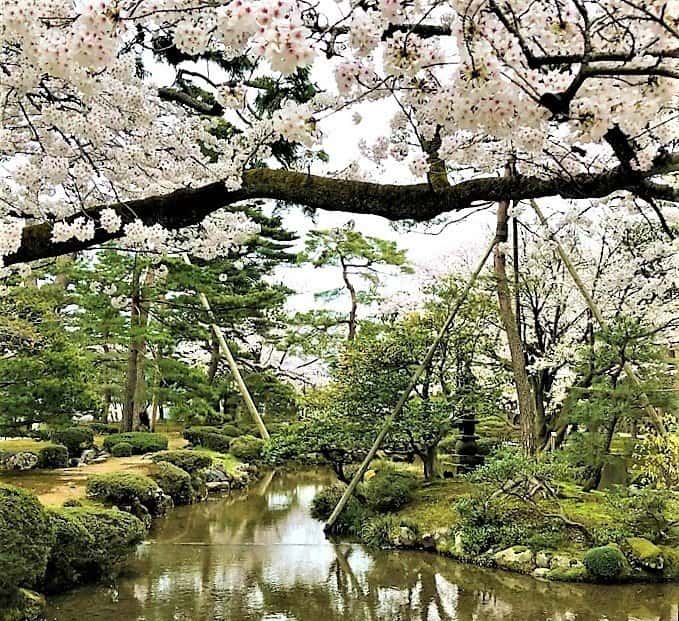
Spring at Kenrokuen Garden / Guide to Kenrokuen Garden
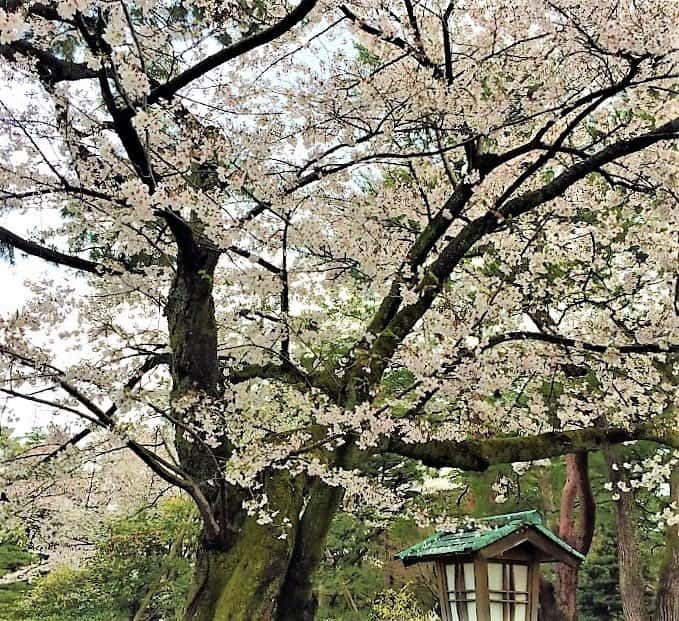
Spring at Kenrokuen Garden / Guide to Kenrokuen Garden
In springtime, the clouds of cherry blossoms block the sky. They fill the air. And, in the end, the delicate petals cover the ground.
Kenrokuen Garden is lit up during the springtime from 6:00 pm to 9:30 pm and you can enjoy yozakura, or night sakura.
Illuminated by both the soft glow of the moon and gentle artificial lights, the yozakura will quickly transport you into a fairytale-like setting.
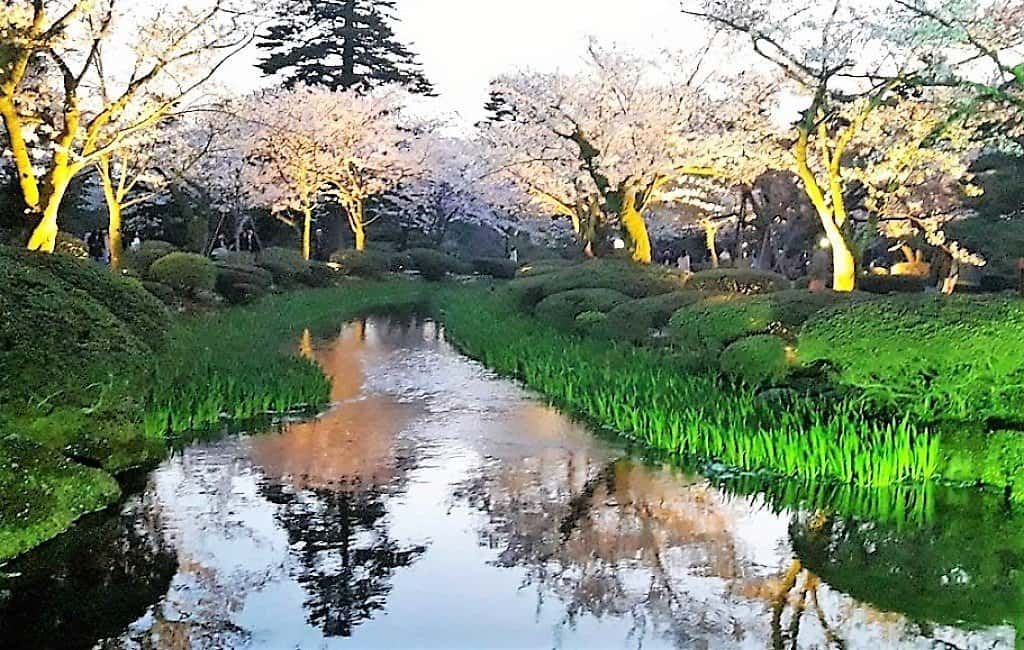
Spring at Kenrokuen Garden / Guide to Kenrokuen Garden
Kenrokuen Garden in the Summer
In the summer, irises fill the waterways with hues of purple. The rich blue-green moss covers the ground and dense greenery fills in every space.
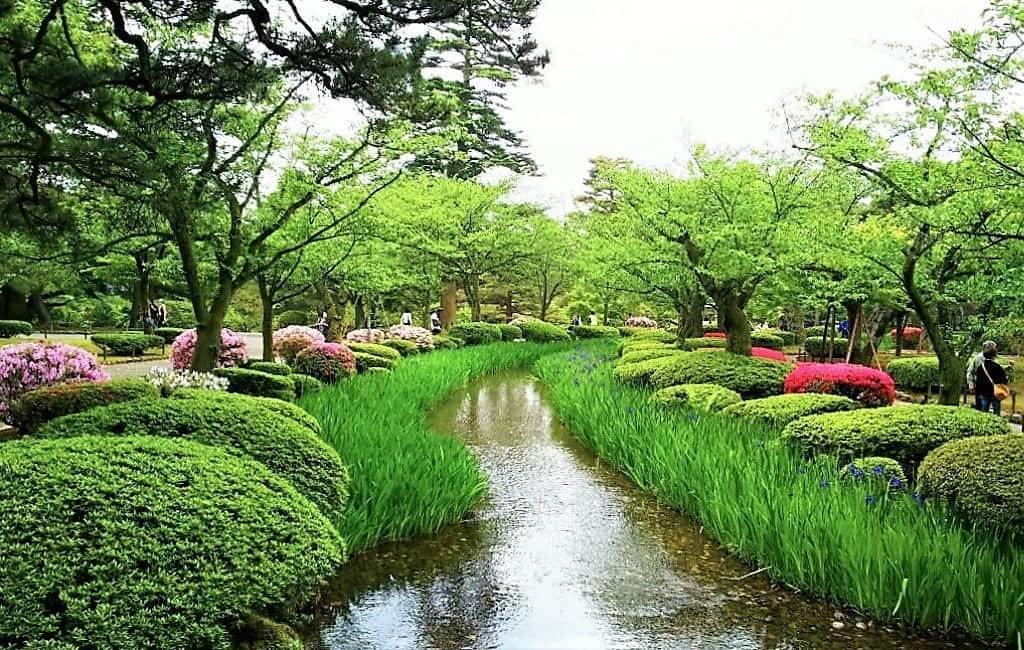
Kenrokuen Garden in the Summer / Guide to Kenrokuen Garden
Fountain (Funsui) in Kenrokuen Garden
Fountain (Funsui) in Kenrokuen Garden is the oldest fountain in Japan. Its water comes from Kasumigaike Pond, and it works by natural pressure caused by the difference in the levels of the two ponds.
Normally the fountain is 3.5 meters high, but its height changes depending on the surface level of Kasumigaike Pond.
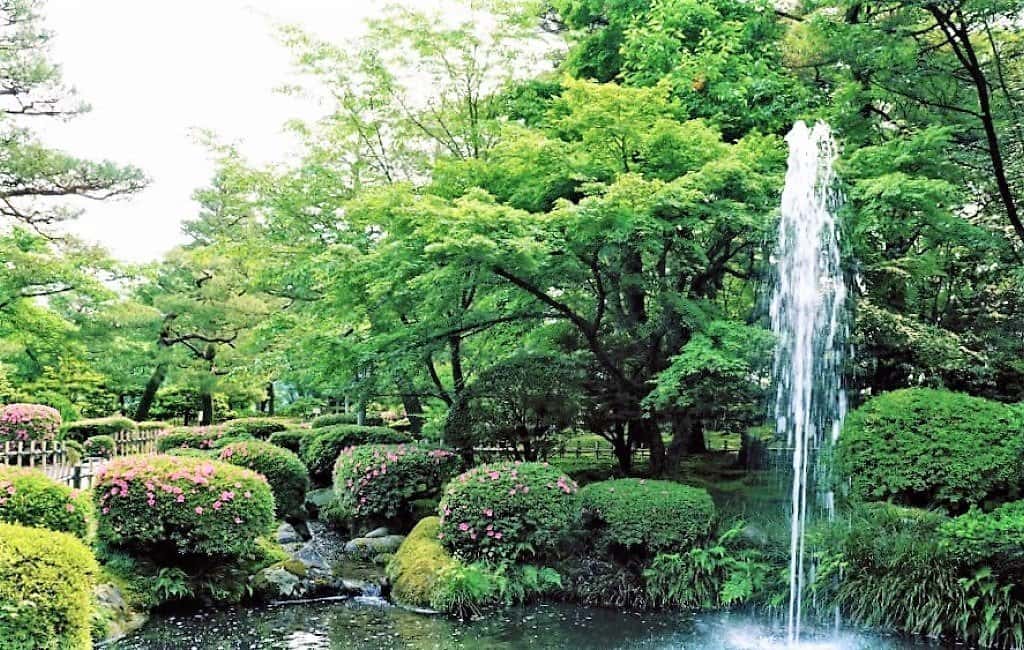
Kenrokuen Garden in the Summer / Guide to Kenrokuen Garden
Teahouses in Kenrokuen Garden
The oldest original building in Kenrokuen is the Yugao-tei teahouse, built in 1774 and named for an ornamental yugao (moonflower) carving that adorns one wall.
The other teahouse is Shigure-tei, which was built before the 1759 fire. It was completely reconstructed in 2000.
Both offer an opportunity to enjoy timeless Japanese tradition, tea ceremony, while being surrounded by the beauty of the garden.
Gankobashi (Flying Wild Geese) Bridge at Kenrokuen Garden
Gankobashi (Flying Wild Geese) Bridge at Kenrokuen Garden is made of eleven red tomuro stones (andesite) laid out to look like wild geese flying in formation.
It is also called “Kikkobashi (Tortoiseshell) Bridge” because of the shape of each stepping stone.
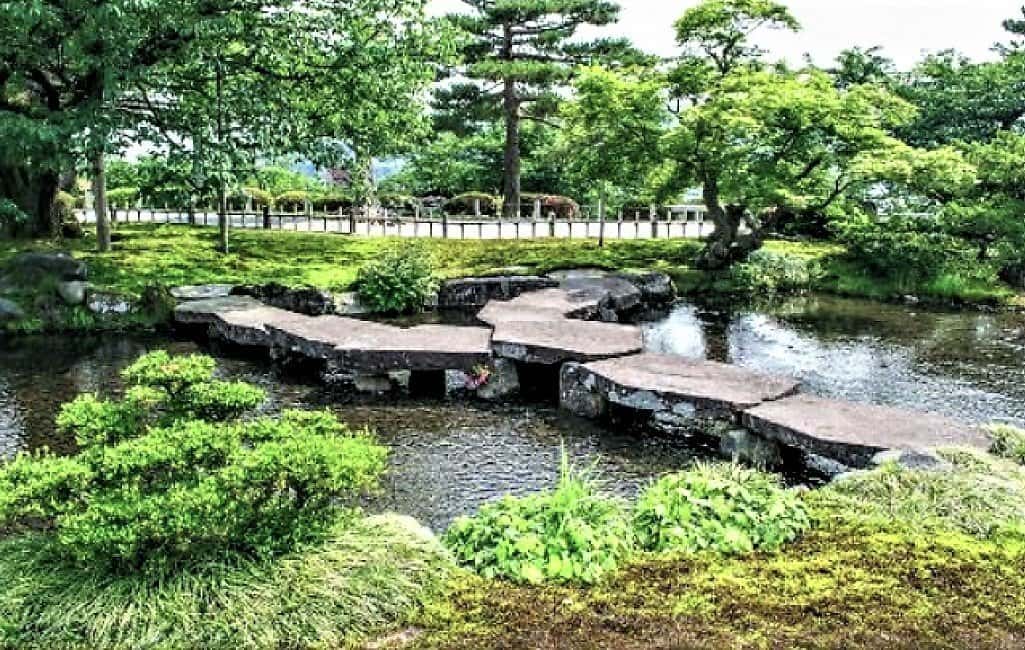
Kenrokuen Garden in the Summer / Guide to Kenrokuen Garden
And, what is more pleasing in the summer than a sound of a stream flowing next to a winding path or a shimmering pond. And, water is abundant in the garden. It is taken in from the Tatsumi Water System, which the 3rd lord Toshitsune ordered to build.
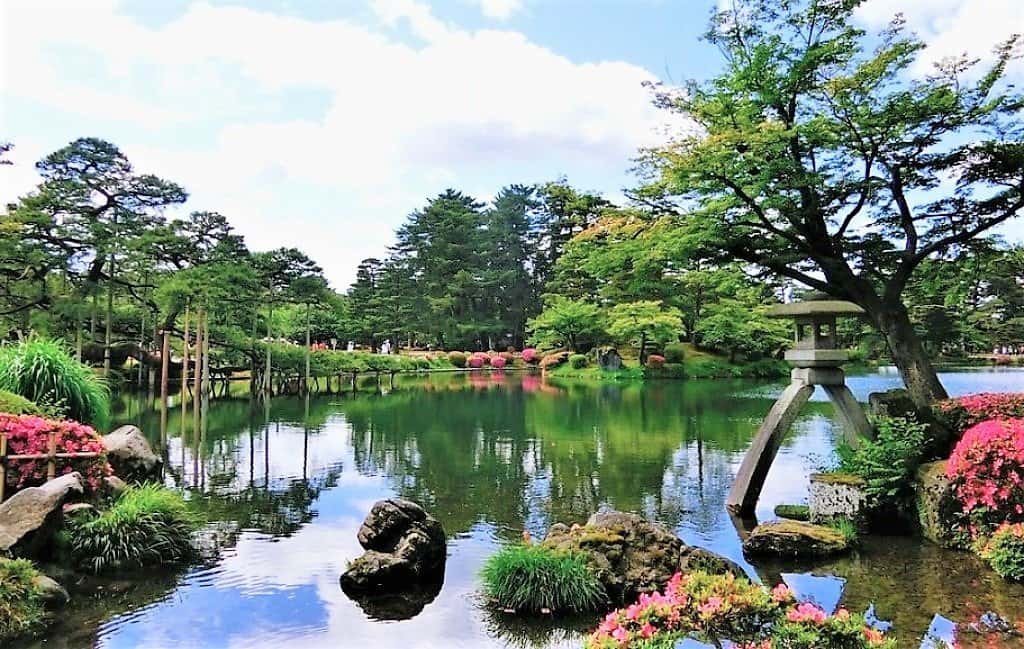
Kenrokuen Garden in the Summer / Guide to Kenrokuen Garden
What fascinates me the most is the attention taken to caring for the old trees. It makes me stop and pause to see each limb carefully held in place by numerous stakes.
While you are wandering through the garden, make sure to take a look at Neagarinomatsu (Raised root) Pine. It is the most interesting specimen.
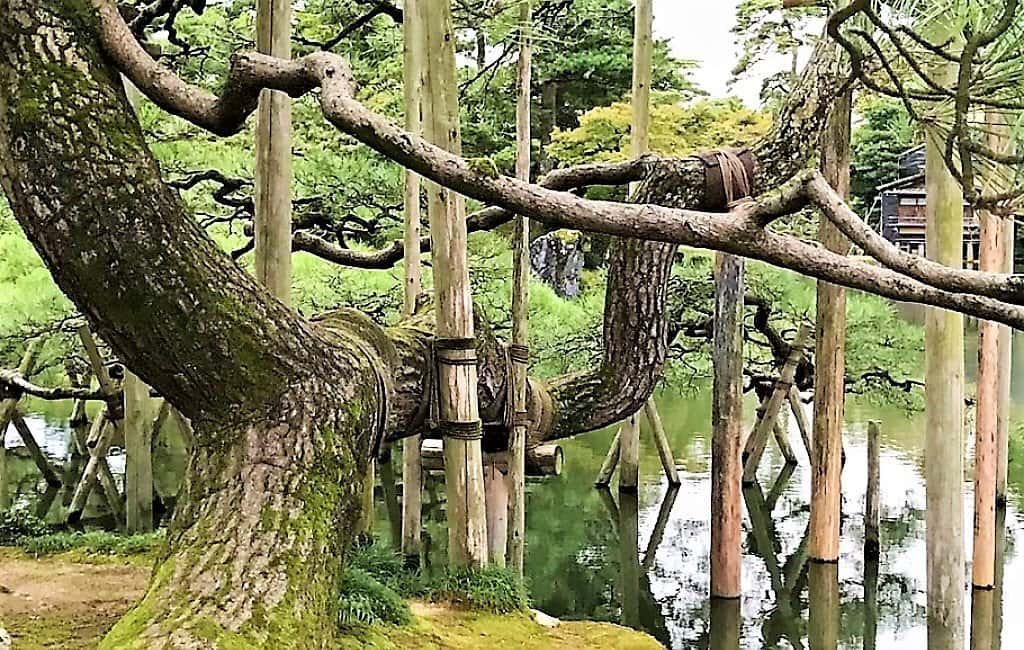
Kenrokuen Garden in the Summer / Guide to Kenrokuen Garden
Kenrokuen Garden in the Fall
In the fall the trees at Kenrokeun Garden dazzle with flaming scarlet, glowing orange, and radiant gold.
Kotoji-toro Stone Lantern at Kenrokuen Garden
The kotoji-toro stone lantern is the most famous structure in the garden. It is built with two legs to represent the bridge of a koto—a traditional Japanese stringed instrument similar to a harp. The lantern has come to symbolize the city of Kanazawa.
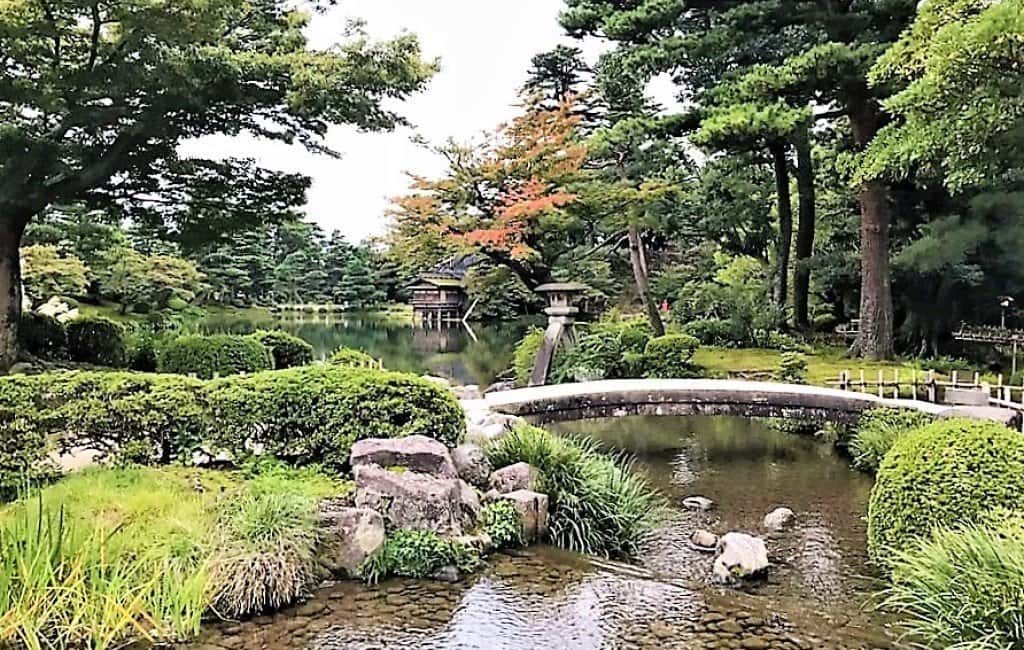
Kenrokuen Garden in the Fall / Guide to Kenrokuen Garden
Each year, as the fall, draws near the end and right before the onset of winter, a team of gardeners begins work on yukizuri or “snow hanging”.
Huge poles are erected among the branches of the pine trees and rice-straw ropes are waved through the branches to hold the huge trees in place.
About 200 ropes surround each tree—but Kenrokuen’s most famous pine, Karasakimatsu, requires a staggering 800 ropes all to itself.
Apparently, the seed for Karasakimatsu was obtained from Karasaki, near Lake Biwa, by the 13th lord Nariyasu. It is from that seed that the pine grew to its present size.
The ropes that cover Kenrokuen’s pines serve a purely practical purpose: when snow falls in Kanazawa, it tends to be dense with moisture, and the ropes prevent the weight of the snow from damaging tree branches.
Yet, they became a beautiful symbol of the changing of the seasons especially when the snow begins to fall and the garden is lit up at night.
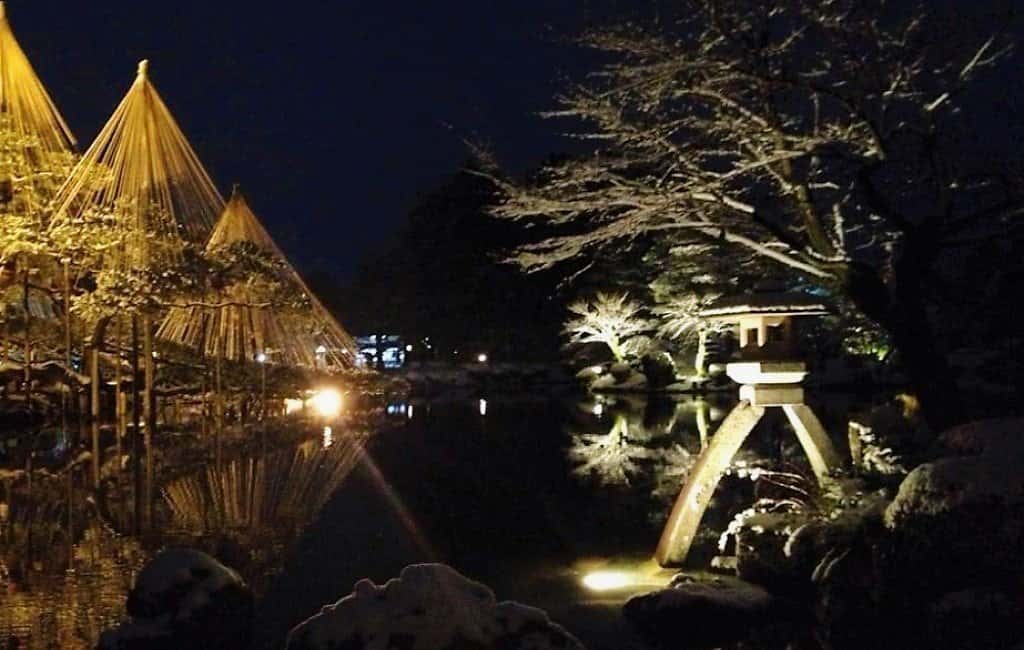
Kenrokuen Garden in the Fall / Guide to Kenrokuen Garden
Winter at Kenrokuen Garden
And, in the winter, the garden exalts the spellbinding stillness.
Some eight thousand trees are hibernating under the heavy snow. Their branches bend with the weight of the snow over the landscaped pathways and ponds.
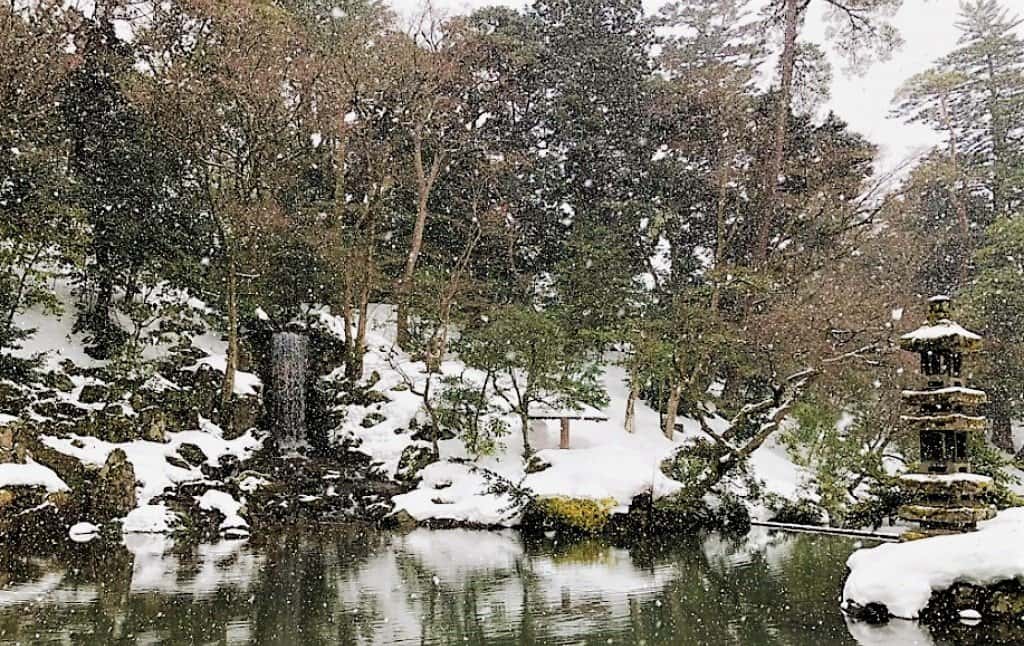
Winter at Kenrokuen Garden / Guide to Kenrokuen Garden
Everything is covered in a snow carpet and the boundaries of master planning are slightly obliterated.
Snow-covered pines, teahouses, bridges, and stone lanterns are reflected in the still mirror of the ponds.
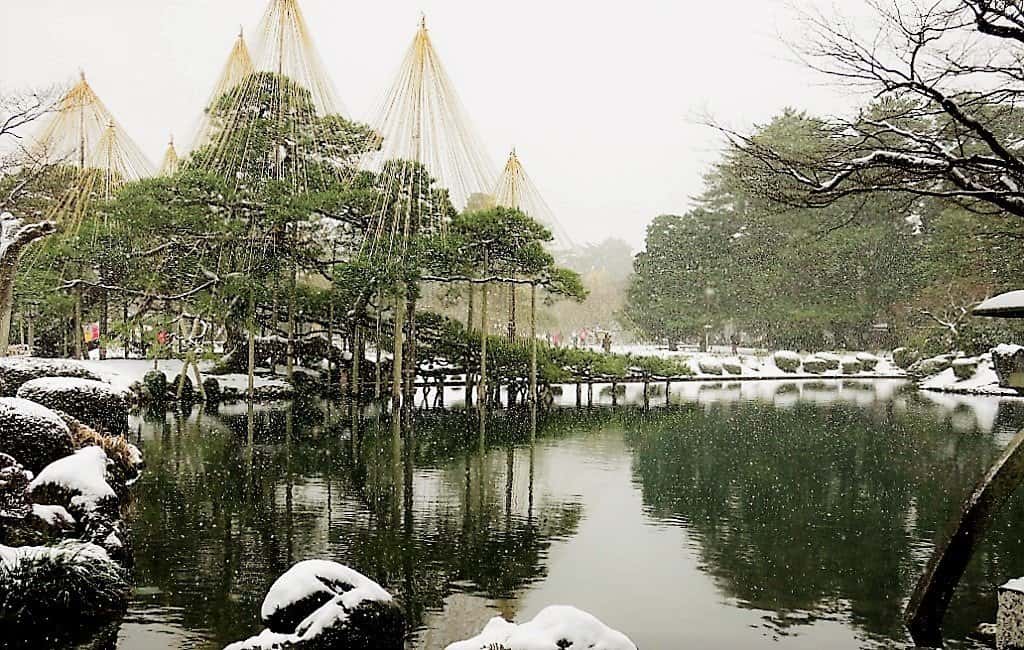
Winter at Kenrokuen Garden / Guide to Kenrokuen Garden
My favorite time to wander around is right at the end of the day. It is when the lights start coming on and the garden comes alive again.
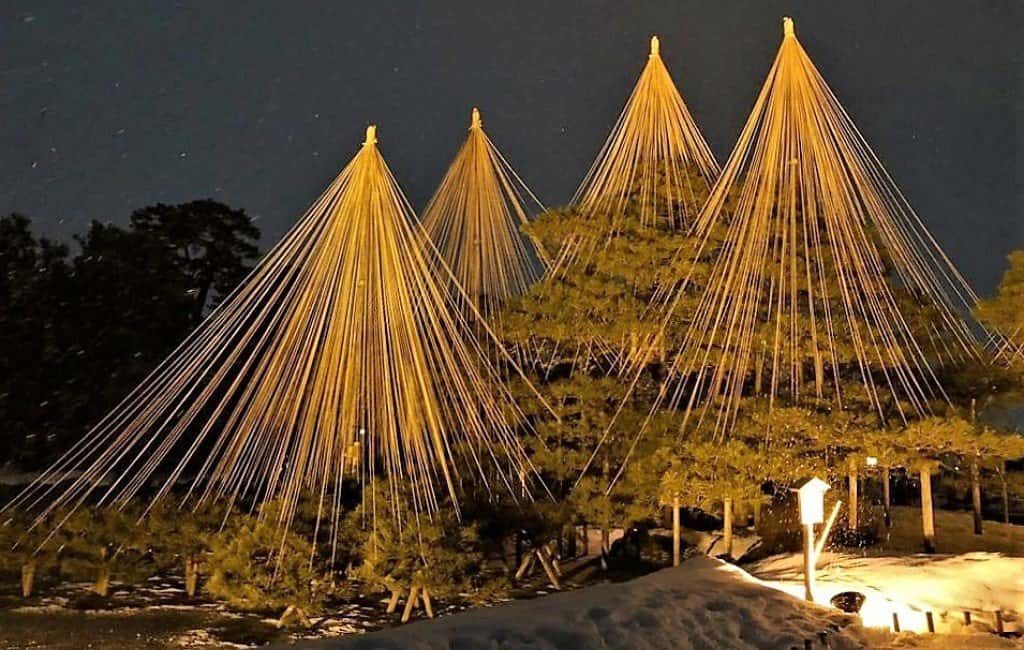
Winter at Kenrokuen Garden / Guide to Kenrokuen Garden
Hours and Admission to Kenrokuen Garden
The opening hours are 7 am to 6 pm (March 1 – October 15) and 8 am to 5 pm (October 16 – end of February). Admission fee is Adult – 300 yen, Child (6-17 years old) 100 yen.
Hours and Admission to Kenrokuen Garden
If you have a JR Pass, then you can take JR Buses in Kanazawa. The cost will be covered by your JR Pass. The JR Buses depart from Kanazawa Station terminal 4. Terminal 4 is located near the Kenrokuen Gate (East Gate). The buses are white with blue trim and JR letters on the front.
There are two routes that the JR Buses cover: Korinbo and Owaricho Routes. The buses run about every 20 minutes starting at 8:20 am. Prior to 8:20 am, there is a bus at 6:45 am, 7:10 am, and 7:20 am.
Now, make sure to board the bus that is going on Korinbo Route and get off at Kenrokuen Garden and Kanazawa Castle stop (stop number 6). It will take you about 15-20 minutes, depending on the traffic, to get to the garden. It is about a 5-10 minute walk to the garden gate.
If you do not have a JR Pass, you can take regular City Bus number 3 or 6, and make sure to get off at Kenrokuen and enter the Kenrokuen Garden through Katsurazak Entrance.
Or, take City Bus number 10 and get off at Hirosaka and enter the garden through Mayumizaka Entrance. Either way, it will take you 15-20 minutes to get to the garden. It all depends on the traffic. It is about a 5-10 minute walk to either gate from the bus stop.
Here are Some More Useful Posts About Japan:
Stunning Kasuga Taisha Shrine in Nara (7 Best Things to See)
14 Amazing Things to Do in Arashiyama (Map+Useful Tips)
What to See at Nijo Castle in Kyoto (10 Top Things to Know)
Stunning Golden Pavilion in Kyoto (How to Visit and What to See)
Amazing Fushimi Inari Taisha in Kyoto (8 Things to Know Before You Visit)
First Visit to Kyoto – How to Visit and What to See (11 Things You Can’t Miss)
2 Days in Kyoto: The Perfect Kyoto Itinerary
10 Amazing Things to Do in Hiroshima on Your First Visit
Perfect Day Trip to Miyajima from Kyoto, Osaka, or Hiroshima (9 Things You Can’t Miis)
You Might Also Like:
What to See at Osaka Castle (5 Amazing Things You Can’t Miss)
WHAT to EAT at Osaka KUROMON MARKET – 10 Culinary Experiences You Can’t Miss
Now, It Is Your Turn, I Would Like to Hear Back from You!
Are you planning your trip to Kanazawa?
Please let me know! Drop me a quick comment right below!
Click on any of the images below to get inspired and to help you with the planning process for your trip to Kanazawa!
